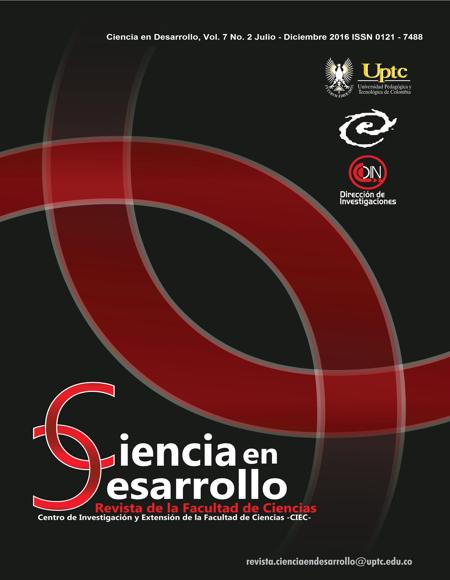Predicción de la capacidad calorífica molal aparente y concentración micelar crítica (cmc) en soluciones acuosas de amonio cuaternario en función de temperatura (283.15 a 298.15) K. / Prediction of Molal Apparent Heat Capacity and Critical Micellar Concentration (cmc) of Aqueous Solutions of Quaternary Ammonium Salts at Temperature (283.15 to 298.15) K.

Resumen
Resumen
El objetivo de la investigación es predecir la capacidad calorífica molal aparente () de las soluciones de líquidos iónicos de amonio cuaternario de Bu4NBr, sec-Bu4 NBr, iso-Bu4NBr, BuEt3NBr y Bu2Et2NBr mediante la ecuación de Pitzer modificada en función de temperatura (283.15 a 298.15) K en el rango de concentración (0.09 a 1.1) m. Se calculan las funciones para la capacidad calorífica mediante la metodología de superficie de respuesta. La concentración micelar crítica para las sales es calculada alrededor de (0.4 a 0.45) m a 298.15 K mediante el modelo de Desnoyers. Se encuentra que los números de agregación para la solvatación (n) varían entre 11 a 16 a 298. 15 K. Se proponen las relaciones estequiométricas de solvatación para cada sal.
Abstract
The aim of the research is to predict the apparent heat capacity (Cfp) of aqueous solutions of quaternary ammonium liquid ionics of Bu4NBr, sec-Bu4NBr, iso-Bu4NBr, and Bu2Et2NBr BuEt3NBr by Pitzer equation modified depending on temperature (283.15 to 298.15) K at concentration range (0.09 to 1.1) m. The functions of the heat capacity are calculated by surface response methodology. The critical micelle concentration for salts was found around (0.4 to 0.45) 298.15 K m by Desnoyers model. The numbers of aggregation for solvation (n) ranging from 11-16 to 298. 15 K. The stoichiometric ratios of solvation for each salt are proposed.
Palabras clave
Ecuación de Pitzer modificado, coeficiente osmótico, capacidad calorífica molal aparente, sales de amonio cuaternario.
Citas
- Olivier-Bourbigou H, Magna L. “Ionic Liquids: perspectives for organic and catalytic reactions”. J. Mol.Catal. A 182-183, pp 419- 437,2002 DOI: https://doi.org/10.1016/S1381-1169(01)00465-4
- Belvéze L, Brennecke J, Stadtherr M. “Modeling of Activity Coefficients of Aqueous Solutions of Quaternary Ammonium Salts with the Electrolyte-NRTL Equation”. Ind. Eng. Chem. Res.43, pp 815-825,2004 DOI: https://doi.org/10.1021/ie0340701
- Pitzer K.S. “Thermodynamics of electrolytes. I. Theoretical basis and general equations”. J. Phys. Chem. 77, pp 268-277,1973.
- Pitzer K, Mayorga G. “Thermodynamics of Electrolytes, II. Activity and osmotic coefficients with one or both ions univalent”. J. Phys. Chem. 77, pp 2300-2308,1973
- Clegg S, Pitzer K. “Thermodynamics of multicomponent, miscible, ionic solutions: Generalized equations for symmetrical electrolytes”.J. Phys. Chem. 96, pp 3513-3520,1992
- Amado-González E, Blanco L H. “Isopiestic determination of the osmotic and activity coefficients of dilute aqueous solutions of symmetrical and unsymmetrical quaternary ammonium bromides with a new isopiestic cell at 298.15K”. Fluid Phase Equil. 233, pp 230 - DOI: https://doi.org/10.1016/j.fluid.2005.04.012
- , 2005.
- Amado-González E, Blanco L H. “Osmotic and activity coefficients of dilute aqueous solutions of symmetrical and unsymmetrical quaternary ammonium bromides at 293.15K”. Fluid Phase Equil. 243, pp 166-170,2006 DOI: https://doi.org/10.1016/j.fluid.2006.03.001
- Amado-González E, Blanco L H. “Isopiestic Determination of the Osmotic and Activity coefficients of Aqueous Solutions of Symmetrical
- and Unsymmetrical Quaternary Ammonium Bromides at T (283.15 and 288.15) K”. J. Chem. Eng. Data, 54 (9), pp 2696-2700,2009 DOI: https://doi.org/10.1021/je900216m
- Amado-González E, Blanco L H. “Aplicacióndel modelo de interacción iónica de Pitzer a coeficientes osmóticos de soluciones de KCl en función de la temperatura”. Bistua, 2 (1), pp 31-46, 2004
- Pitzer K. “Activity Coefficients in Electrolyte Solutions”. CRC Press. Boca Raton, 1991.
- Clegg S, Pitzer K.”Thermodynamics of multicomponent, miscible, ionic solutions: Generalized equations for symmetrical electrolytes”. J. Phys. Chem. 96,pp 3513-3520,1992 DOI: https://doi.org/10.1021/j100187a061
- Pitzer K. “Thermodynamics of electrolytes. I. Theoretical basis and general equations”. J. Phys. Chem. 77, pp 268-277,1973 DOI: https://doi.org/10.1021/j100621a026
- Pitzer K, Mayorga G. “Thermodynamics of Electrolytes, II. Activity and osmotic coefficients with one or both ions univalent”. J. Phys. Chem. 77 (19), pp 2300-2308,1973. DOI: https://doi.org/10.1021/j100638a009
- Krishnan C V, Friedman H L. “Enthalpies of Alkylammonium in water, heavy water, propylene carbonate, and dimethyl sulfoxide”. J. Phys. Chem. 74 (22),pp 3900-3907,1970 DOI: https://doi.org/10.1021/j100716a010
- Visser C, Somsen G. “Hydrophobic interactions in mixtures of N,N-dimethyl formamide and water. Model calculations and enthalpies
- of solution”. J. Phys. Chem. 78 (2), pp 1719- 1722,1974 DOI: https://doi.org/10.1021/j100610a008
- Korolev V, Smirnova N, Kustov A. “Temperature dependence of the interaction between two hydrophobic solutes: a calorimetric study”. Thermochim. Act. 427 (1-2),pp 43 -50,2005 DOI: https://doi.org/10.1016/j.tca.2004.08.012
- Blanco L H, Salamanca Y P, Vargas E F. “Heats of solution in water of salts of the type R4NBr and R2R’2NBr”. J. Therm. Anal. Calorim. 92 (3), pp 683-686,2008 DOI: https://doi.org/10.1007/s10973-008-9014-2
- Desnoyers J E, Caron G, Delisi R, Roberts D, Roux A, Perron G.“ Thermodynamic properties of alkyldimethylamine oxides in water. Application of a mass-action model for micellization”. J. Phys. Chem, 87, pp 1397-1406,1983 DOI: https://doi.org/10.1021/j100231a024
- Ben-Naim A.”One-dimensional model for water and aqueous solutions. IV. A study of hydrophobic interactions”. J. Chem. Phys. 128 (10) , 2008 ; doi.org/10.1063/1.2818051 pp 104506.g DOI: https://doi.org/10.1063/1.2976442
- Steigman J, Sussman D. Acid-base reactions in concentrated aqueous quaternary ammonium salt solutions. I. Strong acids and bases, carboxylic acids, amines, and phenol. J. Am. Chem. Soc. 89 (25), pp 6400-6406,1967 [21] Keži´c B, Mazighi R, Perera A. “A model for molecular emulsions: Water and “weak water” mixtures”. Physica A: Stat. Mechan. Appli. 392 (4), pp 567-582,2013 DOI: https://doi.org/10.1021/ja01001a002
- Drain M, Gentemann S, Roberts J, Nelson N, Medforth C, Jia S, Simpson M, Smith K, Fajer J, Shelnutt J, Holten D. “Picosecond to Microsecond Photodynamics of a Nonplanar Nickel Porphyrin: Solvent Dielectric and Temperature Effects”. J. Am. Chem. Soc. 120 (15), pp DOI: https://doi.org/10.1021/ja974101h
- -3791,1998
- Slusher J, Cummings P. “Molecular Simulation Study of Tetraalkylammonium Halides. 1. Solvation Structure and Hydrogen Bonding in Aqueous Solutions”. J. Phys. Chem, 101,pp 3818-3828,1997. DOI: https://doi.org/10.1021/jp963304+
- El Seoud, O. “Understanding solvation”. En: Pure Appl. Chem. 81 (4), 2009, pp 697-707. doi:10.1351/PAC-CON-08-09-27 DOI: https://doi.org/10.1351/PAC-CON-08-09-27
- Turner J, Soper A. “The effect of apolar solutes on water structure: Alcohols and tetraalkylammonium ions”, J. Chem. Phys. 101, 1994, pp 6116. doi.org/10.1063/1.467327 DOI: https://doi.org/10.1063/1.467327